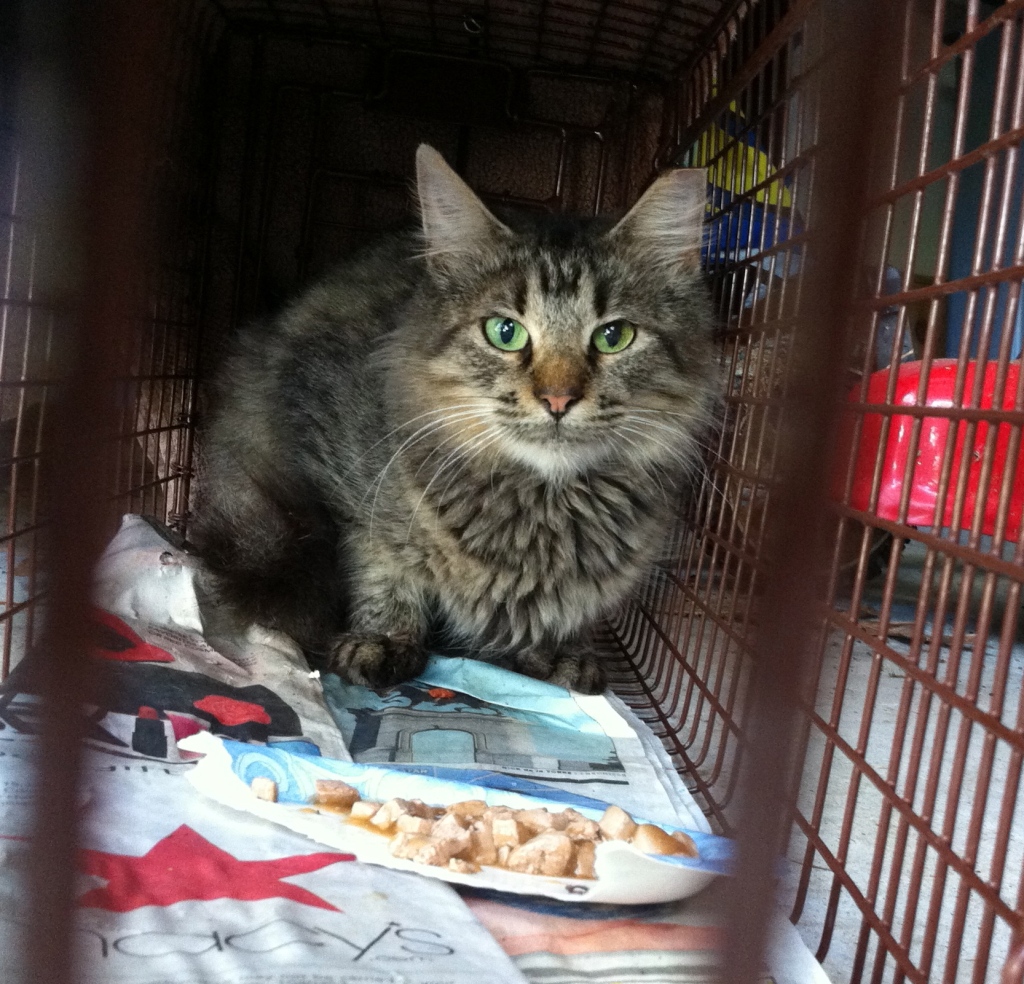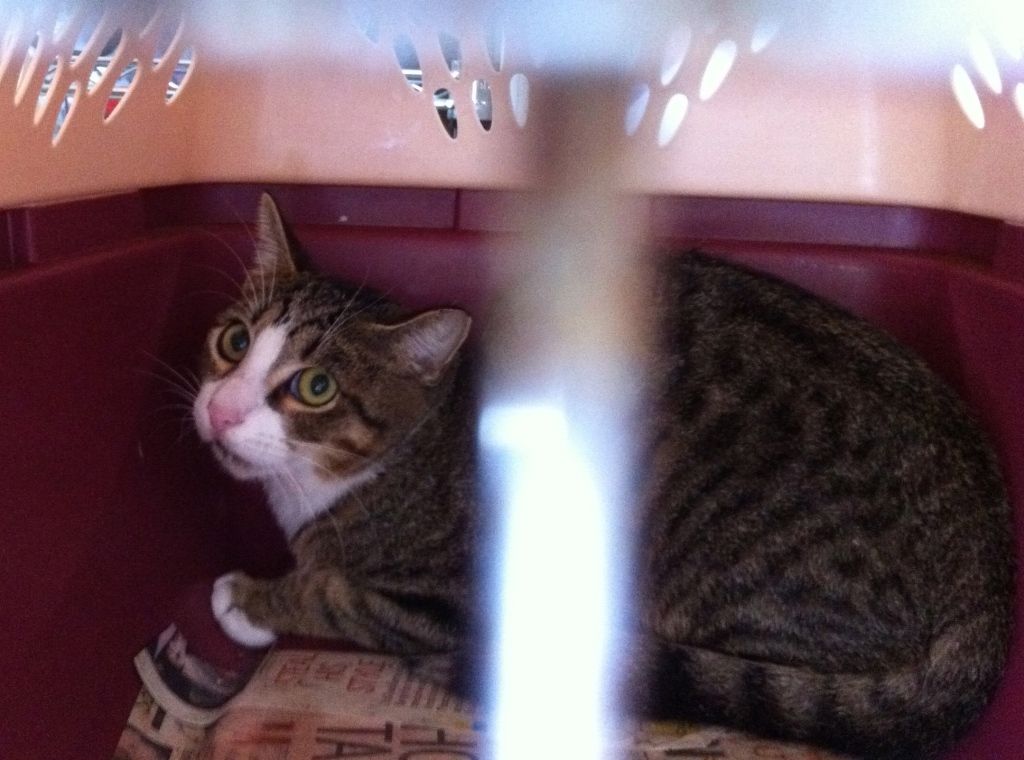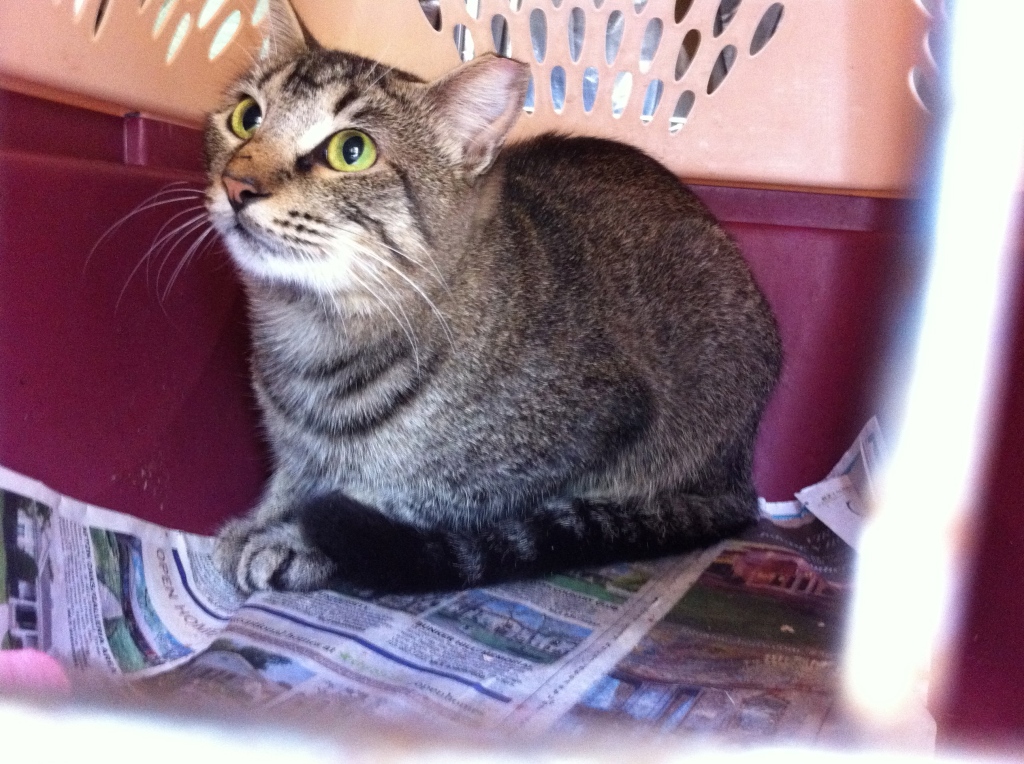Tags
Feral cats, that is.
I know, I know, you’re probably thinking, Wait, this has nothing to do with MS or service dogs or recumbent trikes. But you’d be wrong.
Let me ‘splain.
One of the *very* few things I’m not crazy about with regard to Starbuck (my ICE QNT piece of cycling heaven on 3 wheels) is that it has–what I consider, anyway–a wide turning radius. Not wider than the average recumbent trike, mind you, but way wider than a bicycle. Which means that I have to be careful about where and when I decide to turn around.
Where, because I might come up short in space and reversing the trike is, well, not easy or fun. Mostly because there’s no reverse gear. This isn’t a shortcoming of my particular make and model of trike; no recumbent trike has a reverse gear. Bicycles don’t either of course, but reversing is a bit trickier with that one extra wheel. I should say this is my experience. it’s quite possible–even probable–that reversing is not such a hassle for others as it is for me. Most recumbent trike cyclists, if they come up short in a turn, probably just unclip, stand up, grab the rear wheel, lift, and reposition the trike head-out. Then hop back on, clip back in, and go.
But since I’m a wobbly-wonky woman, that maneuver is a major endeavor for me. Thus, I unclip, use my feet to scootch back while steering into better position, much the same way you’d finagle your vehicle in the back and forth, back and forth motion to get your vehicle out of a tight parking space. It’s time consuming. A little annoying.
The when of all this maneuvering is a factor because if you come up short in the turn and a car is headed toward you, that’s a dangerous situation. It’s happened to me more than once; okay, it’s happened a few times. Because I’m the sort who takes more than the “average bear” to learn what most learn after the first or second bad experience. (it’s a gift, what can I say?) Yogi Bear-smart I am not.
So. (wait for it, we’re circling back to the topic of this post, now) The not-so-tight turning radius of Starbuck is why I happened to turn off a narrow street in my neighborhood to the parking lot of a small Montessori School to circle around safely. At the farthest part of the lot, as I began the first point of my u-turn, I saw a flash of fur and the white of eyes. Which made me stop in my tracks. And made the fur-bound creature stop in his tracks, as well.
His body was snow white, his patches apricot & chocolate, a stunning green-eyed feline. And then I saw a mini dust devil, which was actually two tiny spotted kittens making a mad scramble to get under the porch. One flat-coated, the other a ball of fuzz and fluff.
I went back later with food and water. The sound of pouring the dry food into a plastic container brought six more cats out of the bramble and brush of the field behind the school. One of these new cats, a tabby with a fluffy tail,
was about the same age as the large cat with patches and I could tell she’d recently given birth. In a couple weeks her kittens began to peek their teensy precious faces out from under the house/school. Three black kittens, one with amber eyes, one with green, one with blue. And two heart-stoppingly-gorgeous Siamese, one a blue lynx point, one a seal point. (they’re bigger/older in these photos, that were taken once we trapped them)
They were so thin that it looked as if their fur coats had been stretched too tightly against their wee, fragile skeletons; their ribs were lines of bone-parentheses; their ears too big on emaciated faces, tails too long and unwieldy on their sharp-cornered hips.
The last few weeks have been spent with nightly visits to feed and water the feral cats (two and three visits a day on weekends), getting them used to me, working them up–my husband and I desperately hoped–to something approaching domestication so that we could get them to a shelter or cat rescue. Sadly, during this time, a couple of the cats ended up smushed in the road in front of the school. A stomach-sinking, heartbreaking sight.
Gary and I were able to pet the the male patched cat right away (love bug!) & the tabby momma kitty after the first week, but the others proved a challenge. Eventually I could reach out and skritch the heads of the two Siamese kittens when they were blissfully distracted with eating. Soon one of the calico kittens followed suit,
but her littermate
and her momma–along with the rest of the cats–were too skittish to risk coming close enough to receive affection. It became clear we’d have to use humane traps if we ever wanted to get these cats to a vet for spaying and neutering.
It sounded much easier than it was. But that being said, I want to claim right now the moniker of Feral Cat Trapping Meister. In three nights of trapping I got nine of the cats. I got another, but the crafty little sucker somehow managed to finagle his way out of the trap! I went to the garage the next morning to put him in my car for transport to the vet and the cage was empty, with the two doors in the down and locked position, bungee cords still holding the doors in place. I kid you not. There’s another cat, father of the Siamese kittens I believe, who’s either at large in the area or met a disastrous end in another road because I haven’t seen him for about ten days. I’m hoping he just went on walkabout and will show up again soon.
Thus far I’ve gotten three males neutered and two females spayed. The other adults await their turns, and the smaller kittens need to be a couple weeks or more older for their surgeries. The wonderful Animal Alliance of Galveston County in La Marque does no-cost spay and neuter for feral cats. I applaud them, with grateful heart!
I never realized how many good people are giving their time and energy to TNR (Trap/Neuter/Release) of feral cats in my own community, and I can only imagine it must happen all over our nation. They give their money, too, because even though there’s no charge for the actual surgeries there is a $10 fee for the rabies vaccinations required for all the cats. Recommended is that all the cats get tested for FeLV, because it’s communicable and deadly; that’s a $25 fee. If the cats test positive they are euthanized, since there is no treatment and to release them back to the cat colony or into the wild would be the potential of infecting numerous other cats, thereby causing their deaths. When the woman at Animal Alliance told me the first time I’d either be picking up a newly-neutered cat or an empty cage at 4:30 that afternoon, I dreaded returning.
Luckily, every one of the cats have been negative. I’m praying that trend continues.
Animal Alliance’s main patients are the pets of our community, and they offer low-cost vaccinations, wellness check ups, emergency care, spay and neutering. It was in recognition of the profound need to help lessen the number of feral cats and cat colonies that the clinic took action with its policy to allow five no-cost spay/neuters of ferals each day between Wednesday and Friday. The reason I know how many folks are devoted to helping the feral cats in their neighborhoods is because the first morning I showed up to Animal Alliance at 6:30 (the clinic opens at 7) there were two other women there, each with two feral cats, which meant only one of the five I’d brought would be taken that morning.
The next morning, demonstrating a bit of Yogi’s smarter-bearness, I arrived at 5:30. One of the women from the day before, Miss Manis, was back again with another cat, which, by the way, she transports on a scooter from her trailer park where there’s a cat colony numbering around forty. I brought three cats and another woman brought two–one of which they took, the other she was told to bring back the next day. Others showed up with ferals and were turned away.
Yesterday morning my car hit the gravel of the parking lot of Animal Alliance at 5 and I was actually, finally, the first one there. Then a couple showed up with three cats from a trailer park here in Dickinson not far from my neighborhood. A guy showed up with a feral in a traditional cat carrier, which, come to find out, the clinic won’t accept. All ferals must be in humane wire traps because the cats are so wild that they’re given the sedation shot right through the spaces in the wire, then the vet waits for the drug to take effect before daring to handle the furry beasties.
Our problem now is this: where to relocate this cat colony? The reason we’ve only been able to feed and water, and then trap, in the evenings and weekends is because the owner of the Montessori school is quite frankly a fiendish, unbalanced woman. She refused to take care of the cats and didn’t want anybody else to either. It’s a myth that if you don’t feed and water feral cats that the colony will simply move; it won’t. You end up with starving, sickly animals, who still reproduce. Once they’ve chosen a spot as their habitat they’re staying put unless someone intervenes and relocates them. Even when I told the woman that I was feeding the cats so that I could get them used to me in order to move them, she was irate. She picked up the bowls of food and water and threw them at me. (in front of all the children, mind you)
Hence, stealth feeding and trapping. And now I need a new place to release these cats once they’re recovered from their surgeries. But where?
Three of the tabbies and the black kitten are hissing furbags.
The kitten is still young enough, a teenager, that I think she can be domesticated with some time. Look at her poor wide, scared eyes.
The other three tabbies are full grown and more devoted to hating/fearing humans and I just don’t think I’ll be able to bring them around. But I will try. Shelters and rescues will not take feral cats, did you know that? Well, they’ll accept them, but only to be euthanized.
The momma kitty tabby and her two Siamese kittens, along with the male patches and two calico babies, seem to be already on the road to domesticity. Good news. Still, it will take some time to get them to the point a rescue/shelter will take them because when families come in to look at adopting they want to pick up the cats/kittens and cuddle them. Hissing and scratching doesn’t go over well, as you might imagine. Rehabilitating feral cats, well, that’s something I never anticipated being involved in. But, here I am. And here my poor husband is, right along with me. (he really is saint-worthy that man, I’m telling you)
Let me know if you or someone you know is willing to open heart and home for a rescued, rehabbed cat or kitten. Each one is gorgeous, as you can clearly see with your own eyes. They have distinct personalities and attributes and habits that I’m learning as I go. Feel free to be in touch to find out more about a particular cat/kitten if you’re interested. Each will be spayed/neutered, tested and vaccinated by the time you adopt.
We already have four cats or I’d be keeping these Siamese kittens, that’s for darn sure. I have a thing for Siamese. I have a thing for black cats, too. Well, heck, I’m pretty partial to cats and dogs in general in case you can’t tell. We’re all drawn–for whatever reason–to certain breeds or colors or looks in our pets. I come by the Siamese predilection pretty honestly in that when my parents adopted me a friend of their’s gave them the celebratory present of two Siamese kittens, one seal point and one blue point. (yes, just like these two kittens. stop it. I can’t keep them!) Their names were Mousie & Pyewacket.
If you want your own pair of Siamese goodness, or any of these sweet-faced creatures, please be in touch in the comment section or through my email (on the About page).
Lastly, if you’ve got your own feral cat connundrum to deal with I’ll pass on a couple of tips. The first comes from Miss Manis, the 82 year-old with the huge cat colony in her trailer park: use cooked hot dogs, pulled or cut into small pieces in your traps. The scent really carries, and is apparently irresistable. Thanks to the hot dog tip I was able to catch two of the cats who were incredibly trap-savvy.
The second tip comes from me, and was hard-won in the learning, trust me. It may sound silly but I swear by it. Sing to them. Sing something soft and light and lovely whenever you’re around them. Sing when you feed and water them. Sing when you change the newspaper in the cages. Sing while you’re carrying the cat-leaden traps to your car, to your garage, to the vet and back again.
I don’t know why exactly the singing has such a transformative effect, but I’m guessing it works on cats the same way it does on babies–on many of us. All I know is that it soothes and stills the fear, the wild bristly edges of feral cats. Nothing else I tried did.
My ferals like the Itsy Bitsy Spider song, but feel free to experiment.













When people ask me about a reverse gear on a trike I alway reply: “Yes it has a reverse gear. A Flinstones version ;)” Do not ask how it is to go backwards when you have a trailer attached to it 🙂
All the best!
Peter
LikeLike
Wow, I cannot even imagine trying to back up w/a cargo trailer attached. I think I’d end up in a ditch, for sure.
LikeLike
Pingback: Jetpacks, coming to a kid near you! « WordPlay
Pingback: Found While Triking « Wonky Woman on a Bent Trike
Pingback: Look Into My Eyes « WordPlay
Pingback: The Interview « Wonky Woman on a Bent Trike
Pingback: My Service Dog Is Famous « WordPlay
Pingback: MS150, Please Be Gentle With Me « Wonky Woman on a Bent Trike